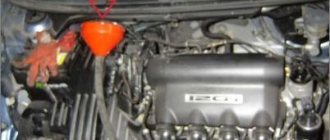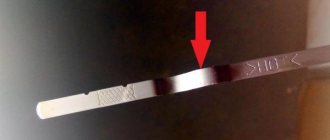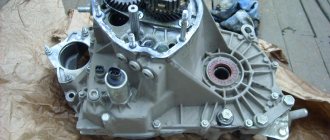We will demonstrate to you the work of changing the oil in the variator of a 2011 Toyota Rav 4 car. A car with a CVT does not have a dipstick for checking the oil level, unlike a classic automatic transmission. In this regard, on the Internet you can often find harmful advice that the oil in the variator is designed for its entire service life and cannot be replaced. In fact, this is not the case; over time, the oil oxidizes and begins to lose its properties; if it is not replaced in time, the variator will simply break.
The oil will be drained when the pan is removed; it is recommended to measure the amount of drained oil so that you can then fill in exactly the same amount of new oil. The level is set using a level tube in a box on a warm car, about 40-45 degrees. To get to the box pallet, you need to remove the plastic protection and one traverse. Using a 6mm hexagon, unscrew the drain plug:
In our case, approximately 1 liter of used oil drained through the plug. Again, take the 6mm hexagon and unscrew the level tube:
The level tube is plastic, so you need to unscrew and tighten it by hand. We wait until more oil has drained, after which we begin to unscrew the pan using a 10mm socket. Then we unscrew the 3 bolts securing the oil filter; in our case, we do not change it, but simply wash it. Be prepared for oil to also pour out from under the filter. We screw the new filter back on. Wash the tray thoroughly and clear its magnets of accumulated chips. We take a new gasket (parts catalog number 35168-20010), we have the original:
The total amount of waste oil drained from the variator was approximately 5 liters. We remove the side plastic boot; it is held on by clips. Using a 24mm socket, unscrew the filler plug:
We insert the hose and funnel there.
We will fill with original oil from Toyota (approximately 5 liters 200 grams):
We tighten the plug, start the car and run the variator in all modes. Then, when the car is warmed up to operating temperature, with the car running, unscrew this plug:
Drain off excess oil.
Video of changing the oil in the Toyota Rav 4 variator:
Backup video on how to change the oil in a Toyota Rav 4 variator:
Although you can often come across statements that the automatic transmission oil is filled for the entire service life of the box (about 250,000 km or more), many believe that a partial oil change in the Toyota RAV 4 variator will benefit the car.
When to change, how much and what kind of oil to fill
It is stated that the acceptable frequency of changing the oil in the variator is 40,000 km.
To replace, you will need a pair of 4-liter canisters of Toyota CVT transmission fluid (oil). About 5 liters will be consumed, more accurately the filling volume will be known after measuring the drained oil
. As much as was drained as a result, that’s what should be filled in.
The necessary consumables for changing the oil in the variator, in addition to the fluid itself, are the variator gasket and the oil filter. Although the latter is often not changed, but only washed and purged.
What is needed to change the oil in the K111F variator
:
- Original oil for Toyota CVT variator - 0888602105.
- Original pan gasket - 3516820010.
Let's sum up the results
Changing the oil in the Toyota RAV4 continuously variable transmission does not require the use of special equipment or special skills. If you wish, you can do the work yourself. Such work at a service station, excluding oil, filter and gaskets, will cost $50-70.
Share with your friends!
- Click to share on Twitter (Opens in new window)
- Click here to share content on Facebook. (Opens in a new window)
- More
- Click to share on LinkedIn (Opens in new window)
- Click to share on Pinterest (Opens in new window)
- Click to share on Telegram (Opens in new window)
- Click to share on Skype (Opens in new window)
- Send this to a friend (Opens in new window)
How to change the oil in a Toyota RAV 4 variator
Changing the oil in the Toyota RAV 4 variator begins with dismantling the protection that prevents you from getting to the sump. You can also dismantle the traverse for convenience; this is not difficult to do.
Next, you need to place a container to drain the oil and unscrew the plug with a 6-point hexagon. This way, about a liter of oil will drain, so when the oil stops dripping, you need to unscrew the level plug
, which is a small plastic cylinder. You should unscrew it by hand so as not to break it.
After this, more oil will drain out, but to carry out the replacement more thoroughly, you need to remove the pan by unscrewing the bolts around the perimeter. Remove carefully as there is still some oil left.
The tray must be cleaned by removing dirt from the magnets.
You should also remove the old oil filter for replacement or cleaning. It is secured with three bolts. After washing and blowing the filter (or taking a new one), you need to install it in the reverse order.
The next step is to install the pan gasket. Due to its design, it does not require sealant, you just need to wipe and degrease
the contour along which the gasket is adjacent to the pallet. Then install the pan back and tighten the plugs.
The filler plug is located on the side, so for convenience you should also remove the protective shield. Then unscrew the plug and, using a hose and funnel, fill in as much oil as drained
. Then you need to tighten the plug.
Now you need to start the engine and run the gearbox through all modes. There is no need to turn off the engine - you need the box to warm up to 43-45 degrees. Then place the container and, with the engine running, unscrew the plug - this will make it possible to drain the excess oil. More oil than necessary will not leak out, thanks to the level plug.
This operation can be performed in a garage if you have basic tools and the necessary skills, or you can entrust it to specialists.
Replacement procedure
Before starting the procedure, you need to purchase and prepare
- new oil recommended by the manufacturer;
- replacement gasket for the pallet;
- fill hose;
- set of wrenches and hexagons.
The design of the variator does not provide for a control dipstick, so it is necessary to monitor the level of drained oil so as not to make a mistake when filling.
- Remove the plastic protection that covers the variator housing. It is held in place by bolts and plastic fasteners.
- Remove the longitudinal beam, which is located slightly to the right of the variator and is attached with four bolts.
- After this, all the bolts that hold the pallet will become accessible. When removing its cover, you need to be careful, because... there is some lubricant there.
- After removing the pan, the drain plug will become accessible. It should be unscrewed with a 6mm hexagon.
- Drain all possible liquid through this hole (volume about one liter).
- Using a No. 6 hex, unscrew the level tube in the drain hole. The liquid will then continue to flow out.
- Unscrew the pan mounting bolts located around the perimeter and drain the remaining liquid.
The height of the drain hole cylinder is more than one centimeter. Therefore, replacing the lubricant without removing the pan (partial) means that some of the used fluid will remain inside.
- Unscrew the three securing bolts and remove the filter. The remaining lubricant will begin to leak out.
- Wash the oil filter and pan thoroughly.
- Return the filter back and install a new gasket on the pan.
- Place the pallet in place and secure it with bolts.
- Screw in the level tube and drain plug.
- Remove the bead protection attached with two clips and unscrew the nut at the top of the variator.
- Add new oil using a hose.
- Reassemble the dismantled parts in reverse order after setting the oil level.
If you carry out this work yourself, without relevant experience, you should use video or photo instructions for greater clarity.
Replacement features
The timing for replacing technical fluids is indicated in the vehicle maintenance instructions. For Toyota Rav4, changing the technical fluid in the variator is not included in the list of mandatory measures, as well as changing the oil in the Toyota Rav4 automatic transmission. Therefore, it will need to be carried out independently after the end of the warranty period.
The frequency of this procedure can be reduced, but it is not recommended to increase it. Especially if the car was purchased secondhand. After purchasing a vehicle outside of a dealership, experts and car enthusiasts recommend a complete replacement of all technical fluids, including the oil in the variator. The likelihood that the vehicle has been used in harsh conditions is very high.
The following oil change methods are available:
- partial substitution;
- complete fluid change.
The latter option is more preferable, since it allows guaranteed service for the node. And this will undoubtedly affect its durability. Official representatives guarantee reliable operation of the variator after reaching a mileage of 200 thousand km.
The fluid in the Toyota Rav4 variator is changed using a technology that differs from that used when carrying out the same procedure in an automatic transmission. Although in both cases the pan must be removed. In order to completely change the oil in the variator, at least 5 liters of technical fluid will be required. It is also necessary to provide for the possibility of using an inspection pit or a lift.
Checking the level
I recommend checking the oil level in the Toyota Rav4 automatic transmission every 10,000 kilometers. If operating conditions are extreme, then reduce the difference to 5000 kilometers.
The verification procedure is carried out as follows:
- Warm up the automatic transmission to 70 degrees.
- Press the brake pedal and move the selector through all gears.
- Place the Toyota Rav4 on a flat surface or hole.
- Turn off the engine and open the hood.
- Unscrew the dipstick and wipe the tip with a lint-free cloth.
- Place the dipstick back into the hole and turn it 180 degrees.
- Pull it out and look at the marks.
- If the oil is at the “Max” level, then leave everything as is. If not, then add about 1 liter.
- Then check the level again.
Read
Toyota automatic transmission repair
Don't forget to look at the rag. If you see that the lubricant remaining on the rag is black and has metallic inclusions, then the transmission fluid should be replaced.
How to set the oil level
After filling, it is necessary to distribute the oil throughout the entire volume of the variator, and also get rid of excess. To do this, you will have to start the engine and hold the variator shift knob in each position for at least 10-20 seconds. During this time, the oil for the Toyota Rav4 variator should heat up to 45 degrees Celsius. Only in this case can you begin to drain the excess liquid.
To do this, without turning off the engine, unscrew the plug located on the pallet closer to the front bumper. Excess oil will drain out of the hole. After the leak stops, tighten the plug and turn off the engine. Reinstalling the plastic protection is the final operation and is not difficult.
This procedure is not suitable if you need to change the oil in a Toyota Rav4 automatic transmission. There is a slightly different replacement technology. Also, when starting this procedure, you will have to stock up on a large amount of lubricant.
A Toyota RAV4, produced in 2015, mileage 50 thousand km, 4 generations, came to us for maintenance. It is necessary to change the oil in the variator. We will show you detailed photos and video instructions on how to do it yourself.
A partial replacement will be performed (without replacing the transmission filter, we will change it at 100 thousand km). Raise the car and use a 6mm hex to unscrew the drain plug:
We place a container at the bottom where the used oil will be drained. Then, also using a 6mm hexagon, unscrew the level tube. We measure the amount of drained oil; we will pour the same volume into the variator. We tighten the drain plug. Our new oil is original 08886-02105 CVT-TC.
We fill it using a funnel and a long tube, the end of which we insert into the filler hole, it is located next to the drain plug, it is shown at the beginning of the video.
After filling, do not pull out the hose. We start the car and run the transmission in all modes. To do this, first switch the selector to reverse, then neutral, then Drive mode and hold it for some time at all speeds. We go under the car and unscrew the drain plug again, draining the oil. We repeat this 2-3 times. Don’t forget to tighten the level tube one last time; we do it by hand.
We start the car for the last time, no longer run it through the modes, but simply warm up the box to 40 degrees, use an electronic thermometer to measure it, measure the pan and body of the box. After this, unscrew the drain plug, all excess oil should drain out. The level tube will prevent more from merging. We tighten the drain plug. Using a carburetor cleaner, wash off the remaining oil from the pan, pull out the hose and put the plug in its place.
In total, with a partial oil change, it took us 7 liters 600 grams. Per 100 thousand km. mileage we will remove the pan and change the oil, performing a complete replacement.
Video of changing the oil in a Toyota RAV4 variator:
Backup video on how to change the oil in a Toyota Rav4 variator:
Read times: 1,245; Today: 1
remontautohelp.ru
How to change the oil on a 5th generation Toyota 5Runner
4th generation 4th generation oil change2018-06-112018-06-19https: //trail4runner.com/wp-content/uploads/2017/08/Trail_4R_Logo-4.pngTrail4R. com - 5th generation 4Runner Modshttps: //trail4runner.com/wp-content/uploads/2018/06/5th_gen_4runner_oil_change_01.jpg200px200px
Step by Step 5th Generation 4Runner Oil Change
Oil change
How to change a 5th generation Toyota 4Runner
There are many different types of maintenance that you can perform on a vehicle, but perhaps the most important is changing the oil in your car. If you want a reliable and long-lasting car, I would suggest changing the oil every 5,000 miles. You may not have to change it quite often with synthetic oil, but it's worth it. You really should only use synthetic oil like Mobil 1. Although the 4Runner is pretty bulletproof, oil changes are necessary and will only help in a smoother, longer lasting car.
WHAT YOU NEED
There are some key components that you will need to change the oil on your 5th gen 4th gen. Here is a list of everything you will need:
HOW TO CHANGE YOUR OIL - STEP BY STEP
Step 1 - Good Location
The first step is to find a place to change the oil in your car. I can fit under my 4Runner without any ramps or lifts; however, if you need or prefer to lift the vehicle, do so accordingly.
Step 2 - Get some latex gloves
Prepare to change your 4Runner's oil by wearing latex gloves. While it's not necessary, I think it's best to try to keep your hands as clean of oils and grease as possible. Using gloves also helps with quick cleanup because sometimes grease can be very difficult to come off of your hands.
Step 3 - Remove the skid plate cover
If your 4Runner is equipped with a front skid plate, you will need to remove a small cover located on the skid plate which will give you access to the oil drain plug.
You will need to remove this cover using a 12mm socket and ratchet. After removing the bolts, install a small skid plate that covers the oil drain plug to the side. I suggest placing the bolts on the top of this small skid plate so you can easily find them once it's time to put that cap back in place.
Step 4 - Remove the Oil Drain Plug
Prepare to remove the oil drain plug and drain the oil from the 4Runner. To do this, you will need a container to catch any spilled oil below. Although some oil is lost due to the operation of the vehicle, plan to lose at least 6.6 quarts (as this is the amount you put in).
After placing a container to catch the oil under the drain plug, use a 14mm socket and ratchet to unscrew the drain plug. Once the drain plug is loose enough, unscrew it by hand.
Be sure to hold onto the drain plug and try not to drop it into the oil container. Once you remove the drain plug, the oil will flow out quickly, so be prepared to move your hand out of the way and let the oil drain into the container.
In the meantime, you can go ahead and wipe any dirt off the drain plug with a clean microfiber cloth. After that, set the drain plug aside for later.
Step 5 - Remove the Front Skid Plate and Cover
While the oil is draining, go ahead and remove the front skid plate and skid plate cover. You may be asking why you should do this, and the simple reason is to change the oil filter. You will not have access to the oil filter unless you remove the front skid plate and skid plate cover.
To remove the cover, you will need a 10mm socket and a ratchet to remove five (5) bolts. There is also one (1) push pin that you will need to remove. Once you remove the cover, you will have access to remove all four (4) bolts that secure the skid plate.
To remove these bolts, use a 12mm socket and ratchet. Tips that are very important: First remove the front bolts from the skid plate. After this, you will need to hold the skid plate while removing the two back ones at the same time. If you don't hold the base plate when removing the last bolt, the base plate will fall and hit you. Although it doesn't weigh too much, it probably won't feel good. The front of the skid plate is on a hinge that releases.
Take your time and rotate the back of the skid plate toward the ground to remove the skid plate from the hinge. Once you remove the skid plate, install it to the side with the bolts or side by side.
Step 6 - Remove the Oil Filter
At this point, you'll want to remove the oil filter - which I think is the most difficult part of the whole process, but is still quite simple. Before removing the filter, reinstall the drain plug and the small skid plate that covers the drain plug. After this, move the container you are using to catch the oil so that it is under the oil filter.
Using a 3/8-inch extension ratchet, remove the metal plug from the oil filter. Some oil will drip, so make sure you have a container to catch it. Your new oil filter should come with a plastic tool to drain the oil later. All you have to do is insert it into the base of the filter. The oil should then drain out. Wait for the oil to drain and remove the plastic drain tool. Along with removing the plastic drain tool, a small O-ring should also appear. It's trash, so throw away the drain tool and the small O-ring.
Now you can remove the filter itself. Use a 64mm filter wrench and remove the filter housing. Be sure to pay attention to the small metal latch on the side of the case. This tab should be aligned in the same location when you turn the filter back on. After unscrewing the filter completely, remove the old filter from the housing and discard it.
There is also an O-ring on the body that needs to be removed. You don't need any prying tools and you can easily remove this o-ring by hand. I recommend doing this by hand as you don't want to damage the plastic threads.
Step 7 - New O-ring from the filter box
Take the new O-ring from the filter box and apply a small amount of oil to it. After that, place it on the filter housing. Make sure it fits all the way around. Then place the new filter into the housing. You don't have to worry about orientation as there is no right way.
Step 8 - Screw the filter assembly back into
Be sure to continue tightening until the metal indicator tab returns to its original position as it was before removing the filter housing. Now install the small O-ring into the filter housing by first coating it with a little oil and then placing the O-ring in place in the drain area of the filter housing. After this, you can install the metal drain plug into the filter housing. You don't need to draw this out too long, so just make sure it's neat.
Step 9 - Oil Change
After checking that the drain plug and oil filter are back in place, install 6.6 quarts of 0W-20 oil in your 4Runner. Use a funnel for this as you don't want to spill any oil on the engine.
Step 10 - Check for Leaks
Once all 6.6 quarts of oil have been installed, check around the drain plug and filter housing to make sure there are no leaks. If you can't spot any, you can go ahead and install the skid plate and skid plate cover.
Step 11 - Resetting the Maintenance Light
Now that you have completed the actual oil change procedure, you need to reset your maintenance light so you know when it needs to be changed. To do this you will need your car key.
Turn the key to accessory mode (as far as the key will go without actually starting the car).
Make sure your odometer shows trip A. If it doesn't, press the knob to the right of the speedometer to move to trip A.
After checking for shutdown A, turn the key to the off position. Press and hold the odometer button and then return the key to accessory mode. The screen should show factory reset.
Continue holding the odometer button until the maintenance light is reset. After that, you can drive another 5,000 miles.
CONCLUSION
While there are some vehicles that make oil changes a little easier, the 4Runner's oil can be changed relatively easily and in a short amount of time.
Since the 4Runner is capable of working in some pretty tight places, you'll need to take the time to maintain your vehicle as best as possible and avoid potential damage.
Taking the time to change your oil every 5,000 miles with a quality synthetic like Mobil 1 will only improve your vehicle's performance, durability and reliability on the track and on the open road.
The dirty truth about how often you need to change your oil
Changing your oil is just one of the many small hassles that come with car ownership, but they are essential to keeping your car in good shape. Additionally, if you don't change your oil on time and with the right products, it could void your vehicle's warranty.
However, experts now say that the standard oil change interval of every three months—or every 3,000 miles (4,828 kilometers)—is old news, and most cars can only go a little further before needing an oil change. If you're changing your oil more often than necessary, this will not help your car. This doesn't hurt either, but you're wasting money, time and resources. Remember also that throwing away oil that is still usable puts a strain on the environment.
There are four main "recommended" oil change intervals, depending on factors specific to you and your vehicle:
- Every 1,000 miles (1,609 kilometers) or every six months
- Every 3,000 miles (4,828 kilometers)
- Every 5,000–7,500 miles (8,046–12,070 kilometers)
- Every 10,000–15,000 miles or every six months (16,093–24,140 kilometers)
Let's look at the circumstances for each.
Change every 1000 miles
First, if some experts say 3,000 miles is too often, why do those same experts recommend intervals every 1,000 miles? It all depends on your driving habits. If your driving pattern consists primarily of trips of 10 miles or less, you should consider changing your oil more frequently than every 3,000 miles for two reasons.
- Unless you drive for long periods of time at high, steady speeds (like on the highway), your engine doesn't get hot enough to boil off the condensation that builds up in the system. This can cause the oil to break down more quickly.
- Most of the wear and tear on your engine happens when you start your car, and unless you drive very far, most of your driving is very hard on your engine. More frequent oil changes will help minimize the damage.
In short, if you drive your car infrequently because the mileage is much less than the recommended service interval, you should still change the oil twice a year since oil degrades over time.
change more often
Some auto experts believe the 3,000-mile interval is actually beneficial for oil change shops because the more often you come in, the more money they make. However, if you have an older model car that recommends this interval, you're probably better off sticking with it.
Scientific American is suitable for longer intervals, especially every 5,000 to 7,500 miles, based on the assumption that this is what most car owner's manuals recommend. Intervals between 5,000 and 7,500 miles are becoming more common, although some manufacturers recommend taking your driving style into account as well. and habits.
For example, if your car is fairly new and you typically drive for 20 minutes or more at fairly steady speeds (as opposed to stopping and cruising while driving), you're a prime candidate for extending the time between oil changes. However, if your car older, it is better to adhere to the manufacturer's recommended maintenance schedule.
Change every 10,000 miles
If your vehicle's manufacturer recommends synthetic oil, or if you decide to make the switch, you could go up to 10,000 miles or more between oil changes. Although synthetic oil is much more expensive than conventional oil, it has more benefits. It works better than regular oil (see "It's Interesting," below) and is better for the environment.
Opinion differs, however, on whether the upgrade is worth it. While some experts suggest doing it in most cases, Consumer Reports says that, as a general rule, you shouldn't upgrade to a synthetic unless your vehicle needs it. If you frequently tow heavy loads, synthetic oil can help reduce the strain on your engine. If you have a model that is known to be prone to sludge problems (that is, when your engine is clogged with degraded oil residue), synthetic oil can help solve these problems and extend the life of your engine.
What do these lights on the dashboard mean?
It's best to keep track of the miles you drive between oil changes, although some cars make this easier with an indicator that tells you it's time to go to the store, as part of what's called an oil life monitoring system. These systems track your mileage and also use data of your driving, which are analyzed by your car's computer to determine when your car needs an oil change. When the light comes on, it's best to change the oil as soon as possible, but it doesn't have to be urgent.
If your vehicle has an oil life monitoring system, please note that this light is different from the oil pressure light, which lights up on the dashboard if your vehicle's oil is not flowing properly due to low levels, a faulty oil pump, leaks in the system or some other issue. Learn the difference between the two turn signals because if the oil pressure light comes on, you need to stop driving as soon as possible to avoid engine damage.
Get into the habit of checking your oil at least once a month to make sure your car isn't leaking or burning oil. If the level is low, add oil. Good oil should be a clear brown-black color, although the Automobile Association of America warns that color is not the only indicator of oil life. If the oil is cloudy or opaque, it may be time for a change, and if it's milky, your engine may be leaking coolant. If your car has one of the above oil monitoring systems, you may not have a dipstick to check your oil.
Moral of the story? If you are unsure how often to change your oil or how to check your oil between oil changes, consult your owner's manual. These habits will help ensure the longevity of your engine.
,
Changing the oil in the Rav 4 variator
Toyota RAV4 is one of the most popular cars in the SUV class. Due to the short wheelbase and low torque, a CVT is often installed on these cars. The manufacturer recommends performing a complete oil change at least once every 50,000 km or once a year. Despite the high precision of fitting of parts, metal shavings are still formed, which are caught by magnets. Only a specialized specialist can tell by the color of the oil that it is time to change it. Therefore, be guided by mileage.
Step-by-step complete oil change in RAV4
Let's list the main steps:
Briefly about adding oil to the box - the procedure is carried out through the filler hole shown in Fig. 1 (it's at the top of the box):
There are two marks on the dipstick - the level in a cold state and in a hot state. It is necessary to top up only after the box has warmed up and not more than the maximum specified level.
In order to get to the mechanisms for the purpose of washing them, you must first drain the old oil from the gearbox. To do this, you need to remove the plug, having first substituted some container (Figure 2):
On a RAV4, after draining the oil, you need to unscrew the special insert from the same hole using a flat-head screwdriver. Then about another liter of liquid will flow out. This will practically dry the box.
You can dismantle the pallet by unscrewing the bolts around the perimeter. If necessary, you can pry it off with a screwdriver. The perimeter gasket will have to be replaced.
The tray has three magnets on which metal shavings accumulate. It must be removed with a rag made of natural fabric. This way you will be able to collect all the shaving fragments. You can also pressure wash them off.
It is necessary to wash the entire box with gasoline or solvent. It’s also worth removing and blowing out the coarse filter (Fig. 3):
The box is assembled in the reverse order, after which fresh oil is poured.
Contact the professionals
At the service station, technicians will be able to check for other breakdowns caused by untimely change of transmission oil. Also, self-washing may turn out to be of poor quality due to basic ignorance of the structure of the assembly parts. Therefore, if money and time allow, it is better to come to a car repair shop. Defects can lead to complete inoperability of an expensive mechanism.
variator-cvt.ru
Find the right oil for your Toyota
The right grade of oil is essential to keeping your Toyota engine running smoothly. Your Vehicle Guide will confirm the correct rating for your vehicle and your region. Alternatively, use this official online tool to determine which oil to use.
Motor oil is not something you want to compromise on. Using the right lubricant keeps your engine running smoothly and extends the life of your components. In fact, using the wrong grade of oil can be a costly mistake.
This is especially true for diesels, which are very sensitive to the wrong grade. If you or anyone servicing your vehicle changes the oil in your diesel engine with the wrong type of lubricant, it may cause the diesel particulate filter . You might want to look at a four-digit bill to correct this.
Motor oil: what do the numbers mean?
Motor oil is surrounded by a lot of numbers, letters, and jargon, which can make it difficult to find the right brand.
Basically, you need to use oil that has the recommended viscosity value. This is the "thickness" of the oil and is usually displayed on the packaging. An oil with a high viscosity will have a more molasses-like consistency, while an oil with a low viscosity is thinner and more pourable. Modern Toyota engines typically use low viscosity oils. They reduce engine friction, reduce wear and improve fuel economy.
The following table shows recommended oil specifications for all current Toyota models and engine types.
| TOYOTA MODEL / ENGINE | RECOMMENDED ENGINE OIL |
| Aygo | 0W-16 |
| Yaris 1.0 | 0W-16 |
| Yaris 1.5 | 0W-20 |
| Yaris Hybrid | 0W-20 |
| Corolla 1.2T | 0W-20 |
| Corolla 1.8 Hybrid | 0W-16 |
| Corolla 2.0 Hybrid | 0W-16 |
| Camry | 0W-16 |
| C-HR 1.2T | 0W-20 |
| C-HR 1.8 Hybrid | 0W-20 |
| RAV4 | 0W-16 |
| GT86 | 0W-20 |
| GR Supra | 0W-20 |
| Prius | 0W-16 |
| Prius Plug-in | 0W-16 |
| Prius+ | 0W-20 |
| Land Cruiser (all) | 0W-30 |
| Hilux (all) | 0W-30 |
| Proace (all) | Please contact your local Toyota center |
| Proace Verso (all) | Please contact your local Toyota center |
Motor oil: how a specialist can help
When in doubt, contact your local Toyota Center for assistance. Our trained technicians and service advisors know Toyota vehicles inside out and can advise you on the correct oil and maintenance schedule for your vehicle (Proace and Proace Verso). Genuine Toyota engine oil is specially formulated for use with our engines. You can't buy a better oil for your Toyota.
Whether you change your oil yourself or have a Toyota service center do it for you, regular oil changes at the specified mileage or time are important. Even long-lasting oils become less effective over time as repeated cycles of heating and cooling continually degrade the oil.
Your local Toyota center is not the only place to buy genuine Toyota motor oil. Visit our eBay and you can have oil delivered to your home or office. Wherever you buy your Toyota Genuine motor oil, using the correct grade is vital to maintaining your vehicle's performance, economy and reliability.
,
Do-it-yourself oil change in a Toyota Rav 4 variator
Toyota RAV4 is the best-selling Japanese crossover on the Russian market. The machine is endowed with legendary quality and reliability. But you have to pay for trouble-free operation, which is quite fair. But on the other hand, the owners of this popular car do not deny themselves the opportunity to repair the car themselves in order to save at least something. Naturally, it is better to carry out serious work using special devices that are available at the Toyota dealership. As for such procedures as changing the oil in the gearbox, even an inexperienced motorist can handle it. The main thing here is to follow the most important points raised in this article. The article describes the sequence of work for changing the oil in a gearbox using the example of a Toyota RAV4 with a CVT.
Oil change intervals
The oil in the Toyota RAV-4 variator must be changed after 40 thousand kilometers, according to official recommendations. In Russian conditions, you will have to change the oil more often - approximately every 20-30 thousand kilometers.
How much to fill
Sequence of work
- Warm up the engine to operating temperature, after which the car is installed on an overpass or pit. Alternatively, you can use a lift
- Prepare a container for draining the waste liquid
- Use a 6mm hex to unscrew the oil drain plug located under the bottom of the vehicle. After this, the old liquid will flow out into a pre-prepared pan. Please note that about 3 liters of liquid should flow out
- Next, you need to unscrew another so-called level plug - it looks like a cylinder. It is advisable not to use a tool for removal, so as not to damage the thread.
- After removing the plastic cylinder (level plug), a large amount of oil will flow from the hole. Here you need to act carefully and work with gloves. This will avoid getting burns.
- Now let's move on to adding oil. We find the filler hole - it is located on the side. To gain access to the neck, you need to remove the protective shield, and then unscrew the plug. Next you will need a hose and a funnel through which the oil will be poured. It is necessary to introduce as much liquid as drained.
- Tighten the plug and turn on the engine. It should run for 10-15 minutes at idle speed. It is important that at this moment the gearbox warms up to 45 degrees.
- It is possible that more oil was added than necessary. In this case, there is protection - the so-called level plug, which makes it possible to drain excess oil. The process of changing the oil in the Toyota RAV4 CVT is completed.
Video
maslospec.ru
What happens if you don't change the oil on time?
Ignoring oil change intervals and warning signals recommended by professionals leads to unpleasant consequences:
- Contamination of the unit, which affects vehicle controllability.
- Unexpected breakdowns when the vehicle is moving, which can lead to an accident.
- Possible errors in gear shifting and damage to the unit, which is also dangerous while the machine is running.
- Complete failure of the variator.
To prevent such breakdowns in the Toyota RAV 4 CVT gearbox, it is necessary to observe the frequency of oil changes. Then the operating time of the car will increase significantly.
Source
Changing the oil in the Toyota Rav4 variator
Despite the fairly high reliability of modern CVT gearboxes that are installed on Japanese cars, this unit is very sensitive to the volume of oil and its quality. That is why changing the oil in the Rav4 variator is mandatory, although according to some information it is designed for the entire service life of the device.
This operation can be performed in a garage if you have basic tools and the necessary skills, or you can entrust it to specialists.
Replacement features
The timing for replacing technical fluids is indicated in the vehicle maintenance instructions. For Toyota Rav4, changing the technical fluid in the variator is not included in the list of mandatory measures, as well as changing the oil in the Toyota Rav4 automatic transmission. Therefore, it will need to be carried out independently after the end of the warranty period.
The frequency of this procedure can be reduced, but it is not recommended to increase it. Especially if the car was purchased secondhand. After purchasing a vehicle outside of a dealership, experts and car enthusiasts recommend a complete replacement of all technical fluids, including the oil in the variator. The likelihood that the vehicle has been used in harsh conditions is very high.
The following oil change methods are available:
- partial substitution;
- complete fluid change.
The latter option is more preferable, since it allows guaranteed service for the node. And this will undoubtedly affect its durability. Official representatives guarantee reliable operation of the variator after reaching a mileage of 200 thousand km.
The fluid in the Toyota Rav4 variator is changed using a technology that differs from that used when carrying out the same procedure in an automatic transmission. Although in both cases the pan must be removed. In order to completely change the oil in the variator, at least 5 liters of technical fluid will be required. It is also necessary to provide for the possibility of using an inspection pit or a lift.
Replacement procedure
In addition to the oil recommended by the manufacturer, you must have a new pan gasket, as well as a filling hose, a set of wrenches and hexagons. It should be taken into account that there is no control probe in the variator, so it is extremely important to fill in a volume of liquid equal to the drained volume.
How to set the oil level
After filling, it is necessary to distribute the oil throughout the entire volume of the variator, and also get rid of excess. To do this, you will have to start the engine and hold the variator shift knob in each position for at least 10-20 seconds. During this time, the oil for the Toyota Rav4 variator should heat up to 45 degrees Celsius. Only in this case can you begin to drain the excess liquid.
To do this, without turning off the engine, unscrew the plug located on the pallet closer to the front bumper. Excess oil will drain out of the hole. After the leak stops, tighten the plug and turn off the engine. Reinstalling the plastic protection is the final operation and is not difficult.
This procedure is not suitable if you need to change the oil in a Toyota Rav4 automatic transmission. There is a slightly different replacement technology. Also, when starting this procedure, you will have to stock up on a large amount of lubricant.
If the material was interesting or useful for you, publish it on your social network page:
jrepair.ru
Practical advice on choosing oil in a Toyota Rav4 automatic transmission
High-quality original oil in the box plays an important role. Only the original has the necessary technical properties that allow the oil to:
- build up a protective film on metal parts to protect them from premature wear;
- prevent foaming;
- protect copper parts from oxidation.
The original oil will not lose its properties even with severe overheating, and in frosts down to minus 30 degrees it will not freeze.
Write in the comments what kind of lubricant you fill in the Toyota Rav4 automatic transmission?
Original oil
The original oil for automatic transmission of Toyota Rav4 is ATF Type IV with catalog number 0553-00405 and Toyota WS with number 08886-01705. The first oil is recommended for use in automatic transmissions created before 2005, and the second - after 2005.
Read
Original oil and analogues for Toyota automatic transmissions
The oil is sold in black iron liter cans and 4 liter canisters. Manufactured in Russia. There is no clear opinion about the quality of this type of transmission fluid. I personally doubt buying such a lubricant.
Therefore, I usually buy the original from Japan in tin cans. European canisters are gray in color. They only come in five-liter sizes. If you see plastic canisters with this name, then they are from America.
Analogs
This oil has no analogues. Therefore, I would not recommend buying lubricants of dubious quality that are passed off as analogues of this transmission fluid. I believe that ATF Type T IV is the only transmission fluid that needs to be poured into a Toyota Rav4 automatic transmission.
Attention! In addition to following the lubricant replacement schedule, do not forget to check the level and add oil as necessary.
Changing the oil in the Toyota Rav 4 variator
In the Russian market, Toyota Rav 4 occupies a leading position among Japanese-made passenger cars. The latest generation vehicle of this brand is rightfully considered an ideal car for active recreation. The new Toyota Rav 4 is equipped with a powerful engine, which ensures a long service life of these machines. However, in order for a vehicle to last for a long time, it is necessary to take care of the safety of its parts and systems.
One of the most important procedures for ensuring the safety of the Toyota Rav 5 is changing the oil in the variator. But what is the need for this event? How to choose the right gear lubricant? How to properly update the oil in a Toyota Rav 4 variator, according to the instructions? Are there significant differences in the procedure for changing transmission lubricant in cars of the brand in question of different generations?
The need to change the oil in the variator
A CVT gearbox (common name - variator) is a continuously variable gearbox. The international name for this structural element is Continuously Variable Transmission (CVT). The functions of the variator are:
- Receiving informative signals from switches and sensors and processing them;
- Stabilization of pressure in the engine during vehicle operation;
- Switching gears while driving.
Manufacturers of Toyota Rav 4 state that changing the oil in a CVT transmission is not a mandatory procedure. However, the official point of view differs from the position of the majority of car owners. If you do not change the technical substance once every 2 years (approximately 45,000 kilometers), the Toyota Rav 4 systems may overheat, which will entail the risk of an emergency breakdown.
Below are signs of the need to change the oil in the Toyota Rav 4 variator:
- The used transmission lubricant has changed its original shade to a more cloudy one. The oil used has a burning and soot smell, a thick, heterogeneous consistency and foreign metallized particles;
- When the Toyota Rav 4 engine is running, significant noise is heard;
- When driving, the vehicle moves unevenly - jerkily. In some cases, the car does not budge at all;
- When starting the Toyota Rav 4 engine, excessive vibrations are felt.
The car enthusiast should take into account that problems when operating a Toyota Rav 4 car can arise not only when there is a shortage or low quality of transmission lubricant, but also when there is an excess of it. In this case, unexpected difficulties appear when changing gears. If you suspect any problems with this technical fluid, you should check the oil in the Toyota Rav 4 variator. This procedure is performed as follows:
- The vehicle is placed on a flat surface. It is recommended to ensure that the vehicle is in the most horizontal position possible, without ups or downs. Otherwise, there may be errors in the oil level reading;
- Start the Toyota Rav 4 engine;
- Stop the engine, but do not wait for it to cool down. It is necessary to measure the oil level in the car's variator until it has cooled down;
- A dipstick is removed from the hole in the variator. Most often, the outer part of this part is presented in the form of a yellow ring. The dipstick should be thoroughly wiped with a dry cloth or towel and immersed back in the transmission lubricant;
- Take out the dipstick again and check which of the marks located on it reaches the oil in the variator. If the technical fluid level is at the middle mark of the dipstick, slightly higher or slightly lower, this is a good indicator. If the transmission lubrication indicator exceeds o or is at or below o, then it is necessary to take action.
When checking the level of transmission lubrication in the variator, it is important to pay attention to its condition. If the consistency or smell of the oil has changed, it should be replaced.
Complete oil change in the Toyota Rav 4 variator
Preparing for a complete oil change in the Toyota Rav 4 variator requires extreme care and consistency. A car enthusiast who wants to independently update the transmission lubricant must follow the following algorithm of actions:
- Prepare the necessary tools and items for the upcoming work, namely: Pliers;
- Canisters for draining (up to 10 liters of volume);
- Construction gloves;
- Funnel for filling;
- Clean paper napkins or towels;
- Screwdrivers;
- A set of keys;
- Place the machine on a horizontal platform;
Regarding the last point regarding the Toyota Rav 4, changing the oil in the variator will not take much time and will keep the car in working condition for a long time. The main thing is not to make a mistake in choosing a technical fluid.
Oil selection
On Toyota Rav 4 cars, starting in 2010 (only the European market is taken into account), a CVT began to be installed instead of a standard automatic transmission. The variable transmission in Toyota models is made in Japan, by the specialized company Aisin.
For CVTs of this company, TOYOTA TC oil (code - 08886-02105) or Toyota CVT Fluid TC is most suitable. This gear lubricant is original to Toyota vehicles. Many car enthusiasts prefer to use technical fluid CVT Fluid FE (08886-02505), but its use is not recommended, since this substance is gasoline-saving, which is not fundamentally important for the Toyota Rav 4 engine. Filling will require 5-7 liters of oil.
Step by step oil change
The procedure for changing the oil in the Toyota Rav 4 variator is carried out in several stages. Step-by-step instructions for this procedure are presented below:
- First of all, it is necessary to drain the oil, following this algorithm of actions: Remove the shield that protects the system from dirt;
- Place a drain canister under the drain hole of the vehicle's variator;
- Unscrew the drain plug;
- Drain the used technical fluid. It is important to remember that 3-5 liters of gear lubricant will pour out slowly; in no case is it recommended to speed up this process;
- The drain plugs are tightened and their tightness is checked;
In the process of draining waste fluid from a Toyota Rav 4, you can also replace filters and gaskets. The fact is that the design of this unit is too complex, so even an experienced car owner can make an irreparable mistake when washing, which will lead to serious damage. Therefore, be careful and read the instructions first. If the condition of the CVT transmission requires flushing, this is done as follows:
- The machine is raised so that its wheels do not touch the floor;
- 1 can of flushing agent is added to the recycled gear lubricant;
- The car engine is turned on (for 10-20 minutes);
- The engine is turned off, and the spent technical substance, along with the flushing liquid, is drained;
- Fresh oil is poured into the Toyota Rav 4 variator.
To flush the Toyota Rav 4 CVT transmission, substances like BG Quick Clean for Automatic Transmissions are most often used. These technical fluids are available for use only by suitably qualified service station personnel.
Changing the oil in a Toyota Rav variator of 4 different generations
The procedure for replacing transmission lubricant has not undergone significant changes since the Toyota Rav4 appeared on the Russian market. Thus, changing the oil in the 2011 Toyota Rav4 variator is no different from the corresponding process for the Toyota Rav4-2012. The same is true for updating the transmission fluid in the 2013 model and changing the oil in the 2014 Toyota Rav 4 CVT.
The individual characteristics of each individual vehicle, which may affect the procedure for changing the technical fluid in the variator, are indicated in the operating instructions for each specific vehicle.
Consequences of untimely replacement
If you violate the replacement frequency, or ignore obvious signals about the need to update the oil in the Toyota Rav 4 CVT gearbox, the following unpleasant consequences may occur:
- Contamination of the unit with metal shavings and dense mud masses;
- Sudden disturbances in vehicle movement while driving and, as a result, a possible traffic accident;
- System errors when shifting gears and breakdown of a technical unit;
- Complete failure of the variator.
To avoid possible breakdowns and emergency situations, it is recommended to periodically update the technical fluid in the Toyota Rav 4 CVT gearbox. Then the vehicle will last longer and the risk of losing control of the vehicle will be reduced.
fix-my-car.ru
Complete replacement of transmission fluid in automatic transmission
The complete procedure for changing transmission fluid in a Toyota Rav4 automatic transmission is no different from the partial procedure if you do it without a high-pressure apparatus.
- Repeat all the steps that I described in the previous block.
- Just stop before starting the engine and warming up the automatic transmission. Remove the hose from the cooling system return. If necessary, extend it using an adapter and clamps.
- Insert the free end into the neck of a five-liter bottle.
- Call your partner and ask them to start the engine.
- Black liquid will flow into the container. Drain about a liter and turn off the engine.
- Top up and repeat the procedure.
- Repeat the process of draining and filling the automatic transmission oil until the oil runs clear.
After completing the procedure, warm up the automatic transmission and drive the car so that the oil penetrates into all hard-to-reach components of the machine. Check the lubricant level.
That and changing the oil in the variator - logbook of the 2012 Toyota RAV4 VATA on DRIVE2
Hello everyone. Finally, I changed the oil everywhere, including in the box. I won’t talk about how they changed the oil in the box, gearbox and transfer case. But I’ll tell you about the box: I bought 2 cans of oil (one shared with Dima on the Borontosaurus)) in the end Almost 5 liters of oil were drained, we also bought a filter that came with a gasket. And so the oil was drained, as I already said, almost 5 liters, there was just a coating on the magnets, the oil was dirty but there was no burning smell. After washing everything, they began to put it back together, the gasket that came with the filter was a rare piece of shit - it leaked, in the end, we removed everything anew, put the old METAL gasket together with sealant, we collected everything, filled it with oil, heated the box and drained the excess.
As a result, the box began to work softer, in my opinion.
PS Writing from a phone is not very convenient, the computer is broken. The Mondeo fits very well as a stand for an oil bucket))))











